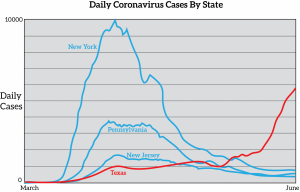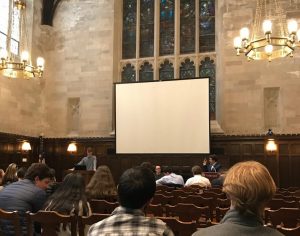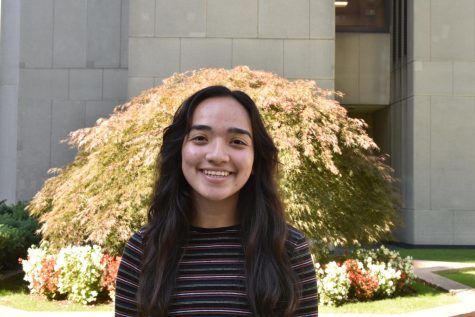New York State’s Proposed Congressional Districts Are Harmful to the State and Democracy
While the new map is to the advantage of New York Democrats, it is not the best move for New York State. By Gabriel Garcia
May 4, 2022
With the 2020 United States Census behind us, American state legislatures’ favorite post-Census tradition is currently underway: the redrawing of congressional and state district maps. Due to the rampant partisan polarization of contemporary US politics, the practice of gerrymandering has increased in recent decades.
Named after Founding Father Elbridge Gerry’s 1812 Massachusetts state senate district plan, gerrymandering is when districts are altered by a political party for their own electoral benefit, according to the definition used by Fordham political science professor Christina Greer in a TED-Ed video.
This common tactic, which politicians from both parties have been accused of using, is controversial because the party in power in a given area can alter voting maps for partisan gain.
Greer goes on to argue that there are two effective strategies to implement gerrymandering, “packing” districts and “cracking” districts. Packing districts involves consolidating the opposition party into as few districts as possible, while cracking districts is the process of cutting a district into several districts to break up a voting bloc, or a population that generally votes for one party over another.
These terms are key for understanding New York’s proposed congressional districts. Currently, the congressional district map approved by the majority-Democratic New York state legislature is in limbo. As it has been deemed unconstitutional by a lower court in New York on the grounds that the map was gerrymandered: the ruling was overturned by an appellate court, and an additional appealed ruling decided against the map.
Maps That Critics Find Maddening
When the New York State congressional district maps were announced back at the start of this year, they created a considerable amount of controversy. The general direction of the new congressional maps in New York is that far more districts will lean Democratic than previously, which is detrimental to the prospects of Republican candidates. To achieve this goal, some New York districts have odd shapes, true to the original origins of gerrymandering.
One of the most publicized elements of the proposed districts is the shifting of New York’s 10th and 11th Congressional Districts. The 10th District is represented by Congress member Jerrold “Jerry” Nalder, while the 11th District is served by Congressmember Nicole Malliotakis. Nadler represents the Upper West Side as well as Hell’s Kitchen, Greenwich Village, Soho, the Financial District, and slices of the Brooklyn neighborhoods of Borough Park and Red Hook.
The proposed 10th congressional district would have encompassed conservative-leaning neighborhoods such as Dyker Heights, while the 11th congressional district would include the Brooklyn neighborhoods of Park Slope and Gowanus, which are reliably liberal voting blocs. These shifts have made the 11th congressional district go from leaning towards electing Republican congressmembers to leaning toward electing Democratic ones.
The major neighborhood shifts of the new Congressional districts led to critics of the new map calling the new districts “jerry-mandered,” after Congressman Nalder. Representative Malliotakis’s 11th congressional district has been “cracked” to give Democrats a better chance to increase their congressional majority.
While the new proposed districts have their critics, they also have some supporters in addition to the New York State legislature. The logic behind supporting New York State’s “ruthlessness” in congressional redistricting seems sound upon first glance: since the Republicans have gerrymandered the states they control, why don’t the Democrats play by the same rules and fight fire with fire? However, this framing of democratic principle vs. partisan self-interest is overly focused on national politics. While the new map is to the advantage of New York Democrats, it is not the best move for New York State.
Partisanship Comes at a Price
A major trend correlated with nationalization of politics is “partisan segregation.” Communities are becoming increasingly homogenous in terms of party affiliation as people move to states, cities and suburbs that more closely align with their political views. I fear that partisan segregation will lead to retribution from states whom mostly have politicians in the opposing party, especially during times of crisis that are statewide or regional.
This has already happened after Hurricane Sandy when Texas Senator Ted Cruz tried to block federal aid in order to punish New York, claiming that most of the funding went to unrelated projects despite the fact that 69% of the bill’s funding was Sandy-related. Ultimately, the two-year commitment to a Republican holding office in New York State’s congressional delegation is still better for the state’s interests than the years or decades long commitment of dissatisfied residents leaving. In that case, New York State would have to deal with the worst of both worlds: no change in the presence of reactionary politics yet increased fiscal precarity, rather than do the harder but more inclusive work of electoral competition.
Many, if not most, New Yorkers want change due to the high cost of living through taxes and an uptick in crime.
While the New York State budget is currently in surplus, that is partially due to COVID relief money from the federal government. Eventually, that money will dry up and aid will lessen as Republicans and “moderate” Democrats refuse to provide more aid. Then, New York will have to confront the loss of hundreds of thousands of residents and the public funding that came with them, weakening the state’s resiliency and self-sufficiency in the long term.
Many, if not most, New Yorkers want change due to the high cost of living through taxes and an uptick in crime. Due to the national two-party system the United States has, one of the few options for change from within is voting for Republicans, which Asians and Latino voters in New York have done in increasing numbers in the 2020 and 2021 elections. While change through the Democratic primary process is still an option, gerrymandering nonetheless entrenches the status quo and limits democratic political choices for voters.
“New York or Nowhere” is a common sentiment for those that live in the city, and I concur with it as a cultural and lifestyle statement. However, it is not a very wise view to hold on a statewide or political level. Beyond the principled arguments for proportional party representation, there are real economic costs as well. States that gerrymander will lose their local sway and undermine the pluralism and diversity of thought on which democracy depends.















